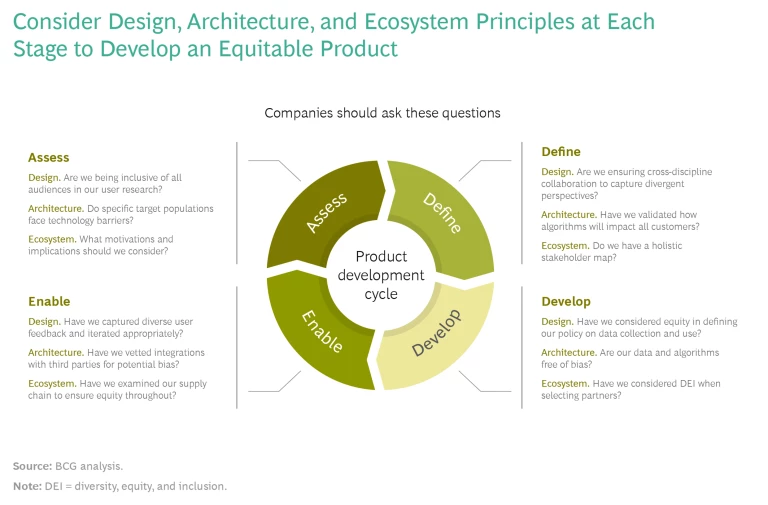Equitable products, built on the concept of human-centered design, increase value by providing a better customer experience and solidifying brand trust.
When a product or service fails certain users because it was not designed with them in mind, everyone involved loses.
We believe that designing inclusive and equitable products is essential. For one thing, offering equitable products—goods and services that are free of bias and can be accessed with equal ease by users from varied racial, ethnic, cultural, economic, and social groups—can expand a company’s user base and boost the bottom line. For another, developing equitable products offers companies a tangible means of delivering on the pledges that many made in the midst of COVID-19 and the racial reckoning of 2020 to be more inclusive and equitable. Equity in the development of products—analog or digital, though digital product development is surging—is a business imperative and a significant growth opportunity that should be driven by an organization’s C-suite and incorporated in the core of the business.
Many companies are moving quickly to tap that opportunity, but they should also move thoughtfully. By redefining product development in a holistic way, companies can ensure that they don’t introduce or perpetuate biases or increase barriers to access and that they, instead, maximize the usefulness and reach of products.
The Nascent Generation of Equitable Digital Products
Many organizations have brought equitable digital products to market, giving careful thought to the needs and circumstances of the product users.
Planned Parenthood’s first digital product, called Spot On, is an app for tracking periods and birth control. It was intentionally designed to be gender neutral and to be used by people of any sexual orientation or gender identity—an approach that is in keeping with the organization’s commitment to providing nonjudgmental care. The free app has been downloaded more than 1 million times.
Automation helps people avoid the conscious or unconscious biases that can influence outcomes in face-to-face encounters.
In the fintech sector, mobile-first neobanks, including Venmo and Cash App, have designed options to deliver flexible financial products to unbanked and underbanked people—people whose needs were exacerbated by the pandemic. During the pandemic, the total payment volume handled by apps like these increased as neobanks made it possible to sidestep the traditional hurdles to establishing bank accounts and to transfer money to help friends and family. Importantly, they also gave traditionally unbanked people access to their government relief checks.
In addition, research has shown that fintech algorithms are 40% less likely than in-person lenders to result in disparate outcomes based on racial and ethnic biases. Automation helps people avoid the conscious or unconscious biases that can influence outcomes in face-to-face encounters. But digital solutions are not necessarily free of biases or challenges. While fintech algorithms are less prone to producing disparate outcomes, Latinx and Black loan applicants still pay a higher interest rate on mortgages—a consequence, perhaps, of reliance on credit data that provides an incomplete picture of people who have had less opportunity to establish a traditional credit history.
Developing equitable products is a necessary endeavor that presents a real market opportunity for companies. While it’s a challenging proposition, it’s worth the effort.
Taking a Holistic Approach
Many companies approach the development of equitable products through a narrow lens, merely reacting to instances of inequity when they surface. AI-based equity failures—like those involving inadequate facial-recognition software—are often addressed in this manner, for instance.
A wider lens allows a product developer to consider demographic and social factors—such as race, gender identity or expression, religion, income, and disability—and expand the number of target users for a product. For example, the UK Government Digital Service uses this approach to develop digital products that can be accessed easily by users who are often overlooked. As part of the effort, the GDS developed representative persona profiles to test the accessibility of products. Among the personas: Ashleigh, who has vision challenges; Pawel, who has Asperger’s syndrome, and Christopher, who has rheumatoid arthritis.
BCG’s approach is a framework that allows a product development team to proactively consider equity from all angles. It, too, relies on a wider lens, and it has several components:
- Three cross-cutting principles
- A four-part product development cycle
- Metrics for measuring success
The components, and the elements within them, should not be implemented linearly or individually. Rather, a team should continuously apply the principles and measure for success at every stage of the cycle—an iterative process that emphasizes ongoing scrutiny, evaluation, learning, and refinement, all in service to the goal of maximizing equity.
Three Cross-Cutting Principles
At every stage of product development, organizations can make sure they are prioritizing equity by considering three fundamental principles that offer high-impact opportunities to intervene if development is veering off track.
Inclusive Design. The product design has to be inclusive to achieve the ultimate goal: an equitable product. To develop products that are inclusive of communities that are often overlooked during the design process, use a human-centered design approach:
- Involve and understand users. Start by recruiting a diverse group for research and testing in order to gain a broad and explicit understanding of users, tasks, and environments. Keep a constant eye on the overall product experience.
- Proceed iteratively, driven by feedback. Seek feedback from target users—and even people who are not target users. Such input helps developers understand unexpected impacts—and opportunities — and determine how to incorporate them in the design.
- Collaborate across multiple disciplines. The design team naturally includes product developers and testers. Cast a wider net. Bring in individuals from other functional disciplines, such as diversity, equity, and inclusion (DEI) or public relations, to tap the value of different perspectives and backgrounds.
A Bias-Free Architecture.
Many digital products
consist of a front end, or smart business layer; a data layer; and a set of key integrations for platform interoperability. For each, carefully consider whether technical decisions increase the risk of bias or exclusion.
- The smart business layer contains the decision engines that process business logic. That logic will either increase or reduce bias, depending on the rules, algorithms, and data used to construct it. Without proper attention, the logic could favor a certain set of demographics and inadvertently produce outcomes that underserve others.
- The data layer powers functionality such as smart decision engines and machine learning, and it is important for accurate analytics. Without a robust data layer, equitable logic and analysis may be insufficient to avoid bias for some user groups. For example, digital redlining has been noted in ride-sharing apps: areas where the population is predominantly white tend to have lower wait times and more accurate pickup information, even when income and population density are controlled for.
- Connectivity, achieved through APIs and microservices, needs to enable a product to work with third-party applications and devices that are likely to be used by the full roster of target users.
Ensure that equity underlies marketing and merchandising as well.
A Committed Ecosystem. Consider equity from the perspective of all those who interact with the product throughout its life cycle.
Be equitable in the selection of diverse suppliers, distributors, and investors. Choose those that demonstrate a commitment to DEI.
Ensure that the marketing of a product will prioritize equity in terms of who it will be promoted to and how. Equity must underlie merchandizing as well: How will the product be accessed? Where will it be available? How will it be displayed?
And, of course, enable programs that ensure diversity, equity, and inclusion in the workplace. A diverse workforce is a valuable resource for the holistic and innovative development of equitable products.
A Four-Part Product Development Cycle
Ensure that designing for inclusiveness is a core component of the entire product development cycle, not just the initial build. All new features should undergo rigorous user acceptance testing. Also, a well-structured customer experience feedback loop should be established to ensure that input, especially input related to equity and inclusion, will make its way back to the product development team.
Four key product development phases are continuously iterated through feedback and testing cycles. (See the exhibit.)
Assess. Start by evaluating the ethical worthiness of the product concept. Determine who stands to benefit, who may be harmed, and whose voices should be present in the product development process. Establish an approach for making tough decisions about ethical worthiness. Identify technical dependencies and gaps that need to be addressed. Understand, too, the limitations that have stood in the way of equity in the past. Look for barriers that may be built in because of technical decisions or limitations. Take this as an opportunity for a truth-telling exercise to understand existing flaws and how to address them.
Define. Next, establish the potential new value—to customers and to the business—by identifying and testing product and service opportunities. Continuously ask, Who is being affected or excluded? Which personas may be missing? Correct course accordingly.
Develop. Begin to realize the new value by designing, building, and deploying the new product or service. By taking an agile, responsible, human-centered approach, development teams can identify and mitigate any factors that may impede access or equity to all personas. Continuously assess the equity of the product, and ensure that users who are most likely to be impacted by inequitable outcomes have a voice in testing.
Enable. Establish the right people, processes, and technologies to achieve the potential of the product. Ensure accountability to the product’s users and to society at large. Consider how the product will integrate with services provided by third-party vendors. Monitor progress and actively address issues as they arise.
Metrics for Measuring Success
Even state-of-the-art principles and product development cycles need to be monitored and measured. A sustainable pipeline of equitable products requires accountability. These accountability checks cannot be piecemeal approaches. A sustained and systemic process is needed. Establishing it will require the organization to recognize and overcome unconscious biases. This will not be an easy undertaking, but it is necessary to ensure that the efforts to develop equitable products are reaching their greatest potential.
Throughout the product life cycle, check for indicators that the team is creating equitable products. Here are some sample metrics:
- Communication with the user community about data collection, use, and gaps is complete, timely, and transparent.
- All target users—and even people who are not targeted—are included in user-engagement sessions; these user groups are continuously refined.
- The selection of a minimum viable product takes equity into account or explains why any aspects of equity may not be included.
- Measurable commitments to equity—both internal and external—are in place across the ecosystem.
- Each product release includes metrics to assess the customer experience and the product’s equity.
- The organization offers incentives for pursuing equity in product design.
Companies that consider the equity of a product only as a postdevelopment fix are missing the opportunity to tap the full potential of equitable products, even beyond the significant value of addressing the current economic and social climate. Equitable products, built on the concept of human-centered design, increase value by providing a better customer experience and solidifying brand trust. They improve market penetration and reach, expand target markets, and diversify the product portfolio. They have value “at home,” too, by increasing employee engagement.
Clearly there’s a lot to be gained by holistically building equity into products. The upfront effort to incorporate equity will pay off. There’s also a lot to be lost if organizations fail to do so, because equitable products are not just a nice-to-have. Ask yourself: What is the true cost of not incorporating equity?













